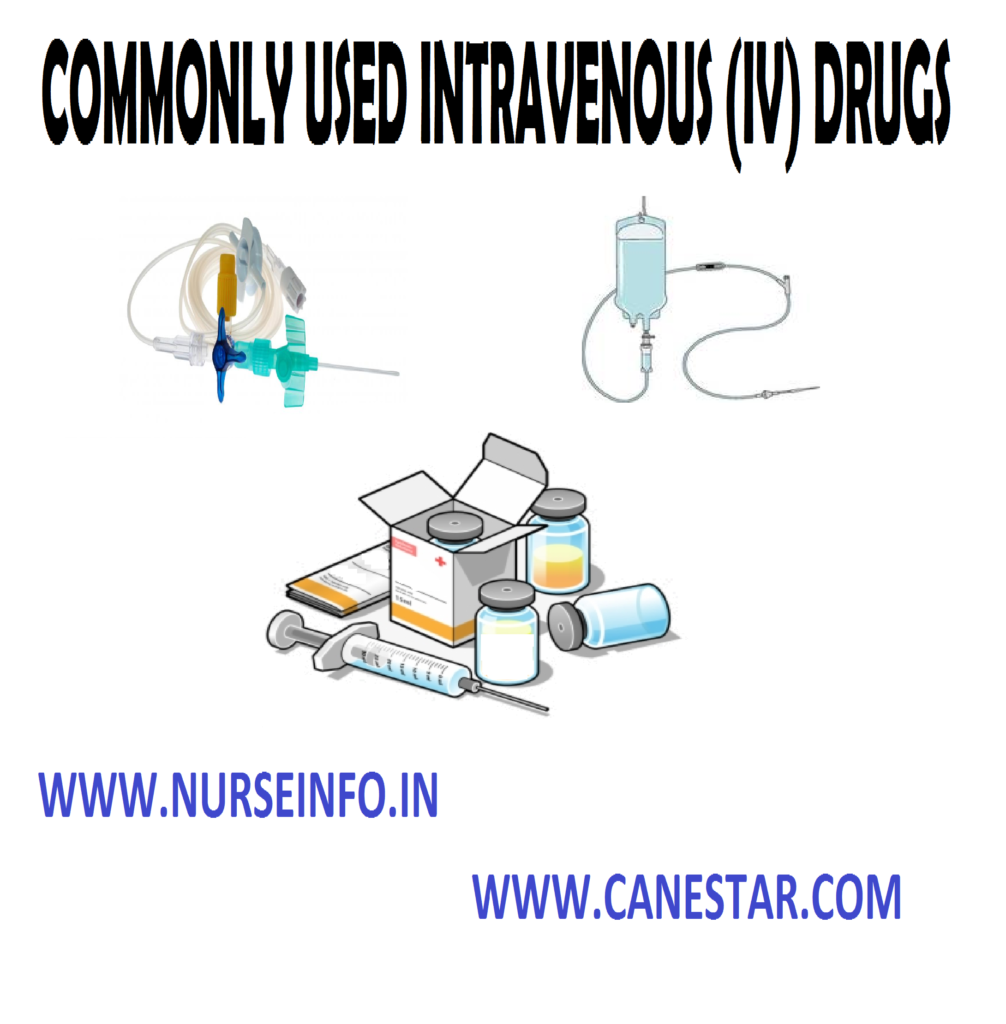COMMONLY USED INTRAVENOUS DRUGS
Antibiotics (Ampicillin, Crystalline Penicillin)
- Indication: treat mainly gram positive infection (e.g. otitis media), meningitis, endocarditis, pneumonia. Act by interfering with bacterial cell wall synthesis – well distributed. Poor penetrator to CSF (except inflamed one). Ineffective against penicillin’s producer bacteria. Safe in pregnancy
Side effect, contraindication (C/I): serious allergic reactions rarely encephalopathy with high dose or normal dose in renal impairment patients. Never to be given intrathecally. Encephalopathy could be fatal. Accumulation of Na+ or K+ for electrolyte restricted patient
- Flucloxacillin: of narrow spectrum but effective against pencillinase producer bacteria of good effect against MSSA (Methicillin Sensitive Staph aureus). Piperacillin known as anti-pseudomonal penicillin. Its activity is extended to cover gram negative bacteria. Indicated when serious infection by P.aeruginosa is suspected
Drug Interaction of Penicillin
With probenecid, reduced excretion of penicillin
Synergistic effect with aminoglycoside against gram negative bacteria
Reduces excretion of methotrexate, increases MTC toxicity
- Cephalosporins: are classified into first, second and third generation and this is determined by the activity against gram negative
They are of broad spectrum (positive and gram negative) act by the same way as penicillin does
- Rochin (ceftriaxone) of longer half-life is given once bacteria and stability against betalactamase enzyme. Daily in preoperatively prophylaxis
- Fortum (Ceftazadine) of good pseudomonal effect. Side effect and contraindication: allergic reaction
- Amikacin-Gentamicin: bactericidal acts against gram negative bacteria including P. aeruginosa
Side effects:
Damage the 8th cranial nerve leads to deafness, ototoxicity
Nephrotoxicity
Excreted via kidneys in renal impairment, accumulation may occur (i) never exceed 7-10 days treatment with Amikacin-Gentamicin. (ii) Never to be given more than TDS/daily. It is given in combination with and hemolytic Streptococci pneumococci. Contraindication in pregnancy. Plasma level monitoring is required for peaks and troughs
Drug interactions
With cyclosporin increase the risk of nephrotoxicity
With cisplatin increase the risk of nephrotoxicity and ototoxicity
- Erythromycin injection:
Indication: alternative to penicillin for penicillin hypertensive patients, good for upper respiratory tract infection, campylobacter enteritis, atypical pneumonia, legionella. Contraindicated, in liver disease (porphyria)
Side effects: if given for more than 14 days – cholestatic jaundice. Avoid concurrent administration of hisminal or teldane
Drug Interaction: erythromycin inhibits hepatic microsomal enzyme leads to increase plasma concentration of antiarrhythmic, carbamazepine, terfenadine, and cyclosporin
- Vancomycin: drug of choice in treatment of pseudomembranous colitis. MRSA, prophylaxis for endocarditis
Side effects/Caution: avoid rapid infusion (anaphylactic shock. Rotate the infusion site. Renal toxicity. History of deafness. Blood disorder should be considered seriously with vancomycin
Vitamin K
Indication: vitamin K deficiency bleeding. Good antidote for bleeding due to overdose of oral anticoagulant
Patient with fat malabsorption (obstructive biliary) are advised to take water soluble forms
Aminophylline
- Indication: indicated alone or in addition to beta 2 agonist to relieve bronchospasm. The drug is metabolized by liver cirrhosis, viral infection – cimetidine, erythromycin. Aminophylline half-life decreased with rifampicin, smoking, phenytoin and carbamazepine. The significance of half-life is important as the therapeutic toxic margin of aminophylline is narrow. When initiating IV therapy with aminophylline we should make sure that the patient was not taking from oral of aminophylline
Side effects: arrhythmia due to hypokalemia, convulsion, GIT disturbance. Aminophylline toxicity is treated by correcting the hypokalemia with KCI (60 mmol/1 hour), tachycardia is treated with IV propranolol
Dopamine/Dobutamine
- They are inotropic drugs, cardiac stimulant, exerting their action through beta 1 receptor at the heart. Indicated in case of cardiogenic shock
- Side effects: tachycardia
- Half-life: it is only 1-2 minutes as they are destructed by MAO. This is why it should be given in continuous infusion. Hypovolemia should be corrected first
Intrathecal Injections
Definition and purpose: medicine injected in the subcutaneous arachnoids space of the spinal canal drugs such as anti-infectious or anti-neoplastic used for treating meningeal leukemia are injected by this route as they do not travel in the bloodstream. It is also given for anesthesia such as lidocaine hydrochloride (for regional anesthesia)
Complications
- Inflammation at the puncture site
- Septicemia
- Spinal deformities especially while giving anesthesia
Note: care must be taken when preparing this kind of injections to ensure that they do not have any bacterial substance
Epidural Analgesia Administration
This procedure is usually performed by the doctor
Purpose
- It is used for pain in deteriorating condition of joints
- To relieve acute pain or chronic in other areas of the body
Procedure: the medicine is injected into the epidural space, which is situated just outside the subarachnoid space where cerebrospinal fluid flows. Medicine get spread slowly into the subarachnoid space of the spinal canal then goes into the spinal fluid (CSF) which carries it directly into the spinal area bypassing (avoiding) the blood brain barrier. However, in some cases medicine may be injected into subarachnoid space intrathecally
Blood-brain barrier: it is a barrier membrane between circulating blood and brain. It prevents any damaging substance from reaching the brain tissues and cerebrospinal fluid
Intra-articular Injections
Intra-articular injections are used when drugs are introduced in inflamed joint, hydrocortisone acetate suspensions are used in this way. Care must be taken to ensure sterile technique
Intracardiac Injections
Intracardiac injections are used for cardiac arrests.
Drug used are: coramine; micron adrenaline 1-1000. They are given in precardial area inside the mid-clavicular space


